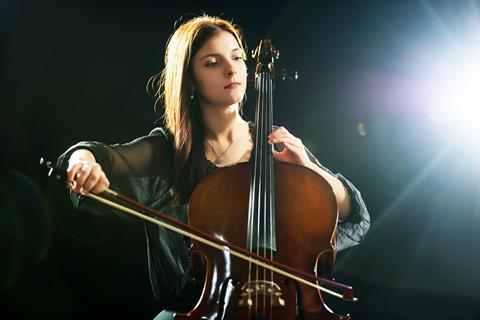As string players, we are often encouraged to make a big sound, but cellist Davina Shum believes that the art of playing quietly is an underrated one

Discover more Featured Stories like this in The Strad Playing Hub
Read more premium content for subscribers here
Fellow string players: I wonder how many times you’ve heard (or thought) the words, ‘Play louder!’, ‘More projection!’, ‘Play to the back of the hall!’
Whether we’re teaching or doing our own practice, we string players place a lot of emphasis on the strength of our sound, and often this is interpreted as ‘big’. Forte, robust, strong and so on are all adjectives that suggest that this sound is unlocked using muscular force, which, when left unchecked, can lead to strain injuries. We then must learn to attain our concert hall-filling sound utilising gravity, with correct weight distribution using the muscles of our back, torso and arms.
Something that I believe isn’t given enough thought is the idea of also utilising this strategy for soft playing. How many of us have practised our pianissimo playing as diligently as we’ve practised our forte playing? And how many string players notice their shoulders creeping upwards towards their ears, with an onset of aches and pains, when told by a teacher, coach or conductor to ‘play quietly’?
Playing softly is tough! It’s harder than playing loudly, because we’re taught how to make a big sound, something that is emphasised in schools – we study the grand staples of string repertoire at the conservatoire, including solo concertos and sonatas, where we’re battling against an orchestra or a beast of a grand piano. It wasn’t until I started playing in orchestras regularly that I wondered, ‘How do we, as a section of eight cellos, make a collective soft sound?’ Moreover, how do I create a soft sound without achy arms and unnecessary tension, and without squirming impatiently in my seat as I wait for those seemingly endless tied ppp semibreves to be over?
How many of us have practised our pianissimo as diligently as our forte playing?
Instruct a young beginner to play quietly and they will learn that this equates to a lighter touch in the bow arm (accompanied by the furrowing of eyebrows, or pursing of lips). But often the instruction stops there, and although that lighter touch might produce enough of a contrast from a simple loud blast, often what can emerge is a wispy, raspy sound, with no core or focus to the note. Because the student is so concerned with creating a quiet sound, they grip the bow for fear of dropping it (even at a young age, stories of broken bows can make a child wince), which causes tension in the fingers, arm, shoulders and neck – all the way up to the aforementioned furrowed eyebrows and pursed lips.
What we perhaps forget is that we already have the tools to play quietly: instead of focusing solely on loud versus soft, we need to focus on tone and quality of sound. I had a lightbulb moment during my university studies while practising Ševčík tone exercises. In order to play with consistent tone, I had to play with balanced posture, keeping my shoulders down even while drawing the bow. I then realised that by focusing on tone, and making micro-adjustments with the bow hand, I could maintain the core of my sound even while playing softly, and without sacrificing my shoulder stance. It took a while for me to trust myself to be able to relax when playing quietly.
Perhaps learning to play strongly with good tone is the key to playing softly with conviction. But we need to remember to continue our sound exploration to include soft playing, so that players aren’t hurting themselves trying to play that way. Furthermore, we need to avoid thinking within the binary constraints of loud equals more pressure and soft equals less pressure.
I invite string players to focus on practising soft playing for once – to practise mindfully and identify exactly what creates that sound that makes audiences lean in and take a collective breath, that makes the hairs stand up on the back of a person’s neck. Your neighbours might thank you for it.
Read: Vibrato: three reminders from our online editor Davina Shum
Read: Musicians have the best weddings with the best music: online editor Davina Shum
Discover more Featured Stories like this in The Strad Playing Hub
Read more premium content for subscribers here
The number one source for playing and teaching books, guides, CDs, calendars and back issues of the magazine.
In The Best of Technique you’ll discover the top playing tips of the world’s leading string players and teachers. It’s packed full of exercises for students, plus examples from the standard repertoire to show you how to integrate the technique into your playing.
The Strad’s Masterclass series brings together the finest string players with some of the greatest string works ever written. Always one of our most popular sections, Masterclass has been an invaluable aid to aspiring soloists, chamber musicians and string teachers since the 1990s.
This year’s calendar celebrates the top instruments played by members of the Australian Chamber Orchestra, Melbourne Symphony, Australian String Quartet and some of the country’s greatest soloists.






































2 Readers' comments